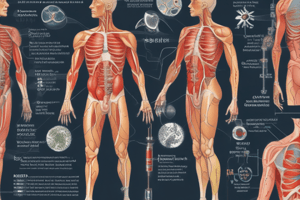Podcast
Questions and Answers
Which statement correctly describes the relationship between pCO2 and pH in the context of acid-base regulation?
Which statement correctly describes the relationship between pCO2 and pH in the context of acid-base regulation?
- A decrease in pCO2 correlates with a decrease in pH.
- An increase in pCO2 leads to an increase in pH.
- A rise in pH results from decreased carbonic acid levels only.
- Increased pCO2 and decreased pH stimulate increased respiration. (correct)
Which of the following acids is classified as a nonvolatile acid?
Which of the following acids is classified as a nonvolatile acid?
- Acetic acid
- H2SO4 (correct)
- B-hydroxybutyrate
- Carbonic acid
In the Henderson-Hasselbalch equation for CO2, what does the term '0.03 * pCO2' represent?
In the Henderson-Hasselbalch equation for CO2, what does the term '0.03 * pCO2' represent?
- The equilibrium constant for the carbonic acid dissociation.
- The concentration of dissolved CO2 in the plasma. (correct)
- The ratio of bicarbonate to dissolved CO2.
- A correction factor for body temperature.
What is the primary function of imidazole in buffering, particularly in the context of physiological pH?
What is the primary function of imidazole in buffering, particularly in the context of physiological pH?
What role does hemoglobin play in acid-base buffering within red blood cells?
What role does hemoglobin play in acid-base buffering within red blood cells?
In a titration curve, what does the buffer value represent?
In a titration curve, what does the buffer value represent?
What physiological condition leads to an accumulation of carbonic acid due to impaired gas exchange?
What physiological condition leads to an accumulation of carbonic acid due to impaired gas exchange?
Which of the following mechanisms is responsible for the regulation of bicarbonate levels in the body?
Which of the following mechanisms is responsible for the regulation of bicarbonate levels in the body?
Which of the following is incorrectly paired with its function in acid-base homeostasis?
Which of the following is incorrectly paired with its function in acid-base homeostasis?
What happens to the acidity of blood when there is an increase in pCO2 levels?
What happens to the acidity of blood when there is an increase in pCO2 levels?
What is a significant consequence of elevated pCO2 levels in the body?
What is a significant consequence of elevated pCO2 levels in the body?
What factor primarily influences the buffering capacity of a solution?
What factor primarily influences the buffering capacity of a solution?
Which physiological mechanism does NOT directly affect bicarbonate levels in the blood?
Which physiological mechanism does NOT directly affect bicarbonate levels in the blood?
How does the Henderson-Hasselbalch equation relate to acid-base balance?
How does the Henderson-Hasselbalch equation relate to acid-base balance?
In what way does hemoglobin affect blood pH during carbon dioxide transport?
In what way does hemoglobin affect blood pH during carbon dioxide transport?
Flashcards
Body Acid-Base State
Body Acid-Base State
The acid-base balance in the arterial blood or extracellular fluid (ECF).
Class 1 Acids
Class 1 Acids
Volatile acids, primarily carbon dioxide (CO2), produced metabolically and removed by exhalation.
Class 2 Acids
Class 2 Acids
Nonvolatile acids like H3PO4 and H2SO4, produced metabolically and removed by the kidneys.
Buffering
Buffering
Signup and view all the flashcards
Titration Curve
Titration Curve
Signup and view all the flashcards
Buffer Value
Buffer Value
Signup and view all the flashcards
Henderson-Hasselbalch Equation (CO2)
Henderson-Hasselbalch Equation (CO2)
Signup and view all the flashcards
COPD
COPD
Signup and view all the flashcards
Diabetic Ketoacidosis
Diabetic Ketoacidosis
Signup and view all the flashcards
HCO3-/CO2 buffer system
HCO3-/CO2 buffer system
Signup and view all the flashcards
Blood pH
Blood pH
Signup and view all the flashcards
Acid-Base Balance
Acid-Base Balance
Signup and view all the flashcards
Buffering System
Buffering System
Signup and view all the flashcards
Respiratory Acidosis
Respiratory Acidosis
Signup and view all the flashcards
Metabolic Acidosis
Metabolic Acidosis
Signup and view all the flashcards
Study Notes
Acid-Base Balance in Blood
- Body's pH is highly regulated for optimal enzyme and transporter function.
- Volatile acids (primarily CO2) are eliminated through exhalation.
- Non-volatile acids (H3PO4, H2SO4) are eliminated through kidney excretion.
- Increased CO2 leads to decreased pH and increased respiration (ventilation to decrease CO2).
Buffering System
- Buffering helps maintain pH homeostasis.
- Acetic acid dissociates into H+ and acetate (its conjugate base).
- Imidazole in hemoglobin (36 histidine) is crucial because its pKa is close to body pH (7.4).
- Hemoglobin carries most CO2 as HCO3- and H+.
- Bone also acts as a reservoir for acids and bases.
Carbonic Acid-Bicarbonate Buffer System
- CO2 dissolves in water, forming carbonic acid (H2CO3).
- The reaction is dynamically balanced.
- The bicarbonate-carbon dioxide buffer system plays a crucial role in maintaining pH.
- This system is under dual control by lungs (managing CO2) and kidneys (controlling HCO3-).
Henderson-Hasselbalch Equation
- pH = pKa + log ([HCO3-] / (0.03 * pCO2))
- This equation allows calculating pH based on bicarbonate and carbon dioxide concentrations and describes the relationship between pH, pCO2, and bicarbonate concentration.
Titration Curves
- Plots the effect of added acid or base on pH.
- The slope of the curve represents the buffer value.
- Strong buffering occurs near the pKa.
Diabetic Ketoacidosis
- Excess B-hydroxybutyrate and acetoacetate contribute to acid accumulation.
Studying That Suits You
Use AI to generate personalized quizzes and flashcards to suit your learning preferences.





